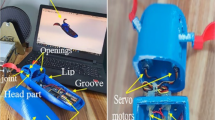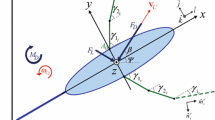Abstract
This paper examines the beneficial effects of the spanwise flexibility of the caudal fin for the improvement of the swimming performance for small fishlike robots. A virtual swimmer is adopted for controlled numerical experiments by varying the spanwise flexible trajectories and the spanwise flexible size of the caudal fin while keeping the body kinematics fixed. 3-D Navier-Stokes equations are used to compute the viscous flow over the robot. Elliptical, parabolic and hyperbola trajectories are chosen to describe the spanwise flexible profile of the caudal fin. According to the sign (positive or negative) of the phase difference of the swinging motion, the spanwise flexibility can be divided into the fin surface of “bow” and the fin surface of “scoop”. It is observed that for both the fin surface of “bow” and the fin surface of “scoop”, the spanwise elliptical trajectory has the optimal swimming velocity, thrust, lateral force, and efficiency. With comparisons, using the flexible caudal fin with the fin surface of “bow”, the lateral force and the power consumption can be reduced effectively and the swimming stability can be increased while reducing little the swimming velocity and thrust. Meanwhile, using the flexible caudal fin with the fin surface of “scoop” can greatly improve the swimming velocity, thrust, and efficiency while increasing part of the lateral force and the power consumption. Three-dimensional flow structures clearly indicate the evolution process around the swimming robot. It is suggested that the fish, the dolphin, and other aquatic animals may benefit their hydrodynamic performance by the spanwise flexibility of the caudal fin.
Similar content being viewed by others
References
Lauder G. V., Drucker E. G. Morphology and experimental hydrodynamics of fish fin control surfaces [J]. IEEE Journal of Oceanic Engineering, 2004, 29(3): 556–571.
Quinn D. B., Lauder G. V., Smits A. J. Scaling the propulsive performance of heaving flexible panels [J]. Journal of Fluid Mechanics, 2014, 738: 250–267.
Zhu Q., Shoele K. Propulsion performance of a skeleton strengthened fin [J]. Journal of Experimental Biology, 2008, 211(13): 2087–2100.
Alben S. Flapping propulsion using a fin ray [J]. Journal of Fluid Mechanics, 2012, 705: 149–164.
Shoele K., Zhu Q. Leading edge strengthening and the propulsion performance of flexible ray fins [J]. Journal of Fluid Mechanics, 2012, 693(2): 402–432.
Alben S. Flapping propulsion using a fin ray [J]. Journal of Fluid Mechanics, 2012, 705: 149–164.
Xia D., Chen W. S., Liu J. K., Wu Z. Effect of head swing motion on hydrodynamic performance of fishlike robot propulsion [J]. Journal of Hydrodynamics, 2016, 28(4): 637–647.
Liao J. C., Akanyeti O. Fish swimming in a karman vortex street: Kinematics, sensory biology and energetics [J]. Marine Technology Society Journal, 2017, 51(5): 48–55.
Curatolo M., Teresi L. Modeling and simulation of fish swimming with active muscles [J]. Journal of Theoretical Biology, 2016, 409(1): 18–26.
Zhu Q. Numerical simulation of a flapping foil with chordwise or spanwise flexibility [J]. AIAA Journal, 2007, 45(10): 2448–2457.
Heathcote S., Gursul I. Jet switching phenomenon for a periodically plunging airfoil [J]. Physics of Fluids, 2007, 19(2): 1–12.
Fish F. E., Legac P., Williams T. M. Measurement of hydrodynamic force generation by swimming dolphins using bubble DPIV [J]. Journal of Experimental Biology, 2014, 217(2): 252–260.
Tangorra J. L., Lauder G. V., Hunter L. W. The effect of fin ray flexural rigidity on the propulsive forces generated by a biorobotic fish pectoral fin [J]. Journal of Experimental Biology, 2010, 213(23): 4043–4054.
Xia D., Chen W. S., Liu J. K. et al. The three-dimensional hydrodynamics of thunniform swimming under selfpropulsion [J]. Ocean Engineering, 2015, 110: 1–14.
Gleiss A. C. Potvin J. Goldbogen J. A. Physical trade-offs shape the evolution of buoyancy control in sharks [J]. Proceedings of the Royal Society B-Biological Sciences, 2017, 284(1866): 1–10.
Dutsch H., Durst F., Ecker S. Low-Reynolds-number flow around an oscillating circular cylinder at low Keulegan- Carpenter numbers [J]. Journal of Fluid Mechanics, 1998, 360: 249–271.
Tytell E. D., Lauder G. V. The hydrodynamics of eel swimming-I. Wake structure [J]. Journal of Experimental Biology, 2004, 207(11): 1825–1841.
Verma S., Novati G., Koumoutsakos P. Efficient collective swimming by harnessing vortices through deep reinforcement learning [J]. Proceedings of the National Academy of Sciences of the United States of America, 2018, 115(23): 5849–5854.
Yuan H. T., Hu W. R. A numerical study of tadpole swimming in the wake of a D-section cylinder [J]. Journal of Hydrodynamics, 2017, 29(6): 1044–1053.
Daghooghi M., Borazjani I. Self-propelled swimming simulations of bio-inspired smart structures [J]. Bioinspiration and Biomimetics, 2016, 11(5): 1–17.
Acknowledgement
This work was supported by the State Key Laboratory of Robotics and System, Harbin Institute of Technology (Grant No. SKLRS-2018-KF-11).
Author information
Authors and Affiliations
Corresponding author
Additional information
Project supported by the National Natural Science Foundation of China (Grant Nos. 51875101, 51375085).
Biography: Dan Xia (1982-), Male, Ph. D., Associate Professor
Rights and permissions
About this article
Cite this article
Xia, D., Chen, Ws., Liu, Jk. et al. Using spanwise flexibility of caudal fin to improve swimming performance for small fishlike robots. J Hydrodyn 30, 859–871 (2018). https://doi.org/10.1007/s42241-018-0100-z
Received:
Revised:
Accepted:
Published:
Issue Date:
DOI: https://doi.org/10.1007/s42241-018-0100-z




